1998 GMC SIERRA window
[x] Cancel search: windowPage 267 of 452
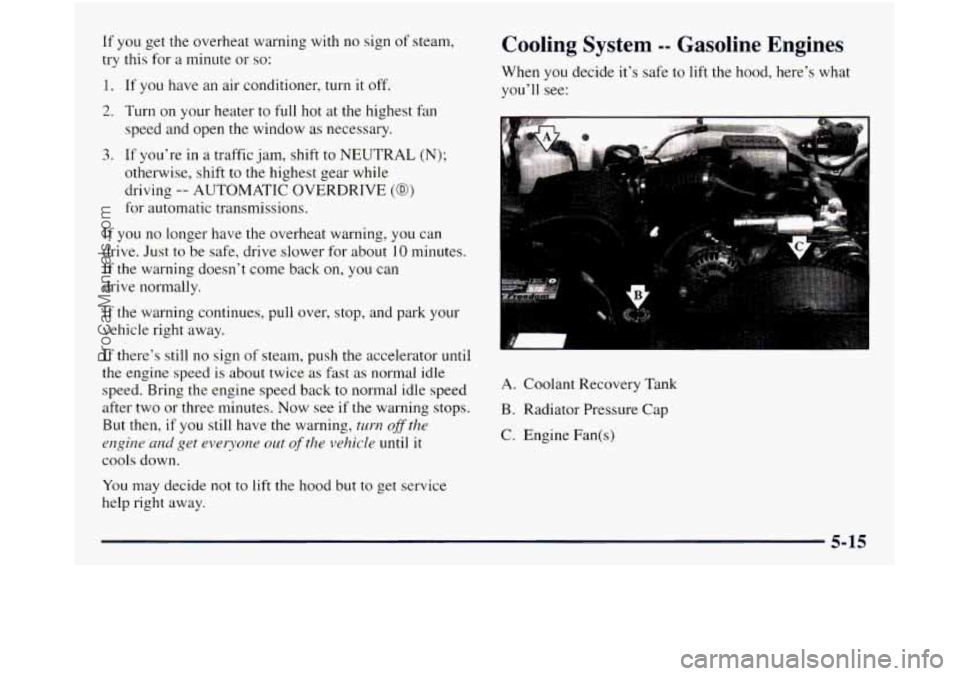
If you get the overheat warning with no sign of steam,
try this for
a minute or so:
1. If you have an air conditioner, turn it off.
2. Turn on your heater to full hot at the highest fan
speed and open the window
as necessary.
3. If you’re in a traffic jam, shift to NEUTRAL (N);
otherwise, shift to the highest gear while
driving
-- AUTOMATIC OVERDRIVE (@)
for automatic transmissions.
If you no longer have the overheat warning, you can
drive. Just to be safe, drive slower for about
10 minutes.
If the warning doesn’t come back on, you can
drive normally.
If the warning continues, pull over, stop, and park your
vehicle right away.
If there’s still no sign
of steam, push the accelerator until
the engine speed
is about twice as fdst as normal idle
speed. Bring the engine speed back to normal idle speed
after two or three minutes. Now see if the warning stops.
But then, if you still have the warning, turn ofthe
engine
and get everyone out of the vehicle until it
cools down.
You may decide not to lift the hood but to get service
help right away.
Cooling System -- Gasoline Engines
When you decide it’s safe to lift the hood, here’s what
you’ll see:
A. Coolant Recovery Tank
B. Radiator Pressure Cap
C. Engine Fan(s)
5-15
ProCarManuals.com
Page 326 of 452
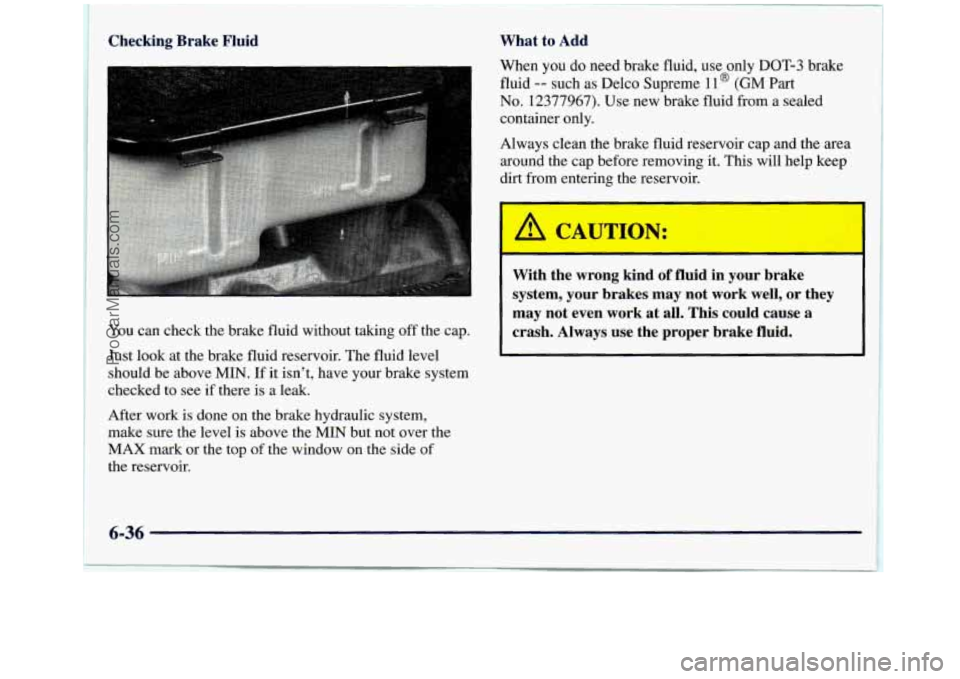
Checking Brake Fluid
You can check the brake fluid without taking off the cap.
Just look at the brake fluid reservoir. The fluid level
should be above
MIN. If it isn’t, have your brake system
checked to see if there is a leak.
After work
is done on the brake hydraulic system,
make sure the level is above the
MIN but not over the
MAX mark or the top
of the window on the side of
the reservoir. fluid
-- such
as Delco Supreme llw (GM Part
No. 12377967). Use new brake fluid from a sealed
container only.
Always clean the brake fluid reservoir cap and the area
around the cap before removing it. This will help keep
dirt from entering the reservoir.
A CAUTION:
I
With the wrong kind of fluid in your brake
system,
your brakes may not work well, or they
may not even work at all. This could cause a
crash. Always use the proper brake fluid.
I I
6-36
ProCarManuals.com
Page 351 of 452
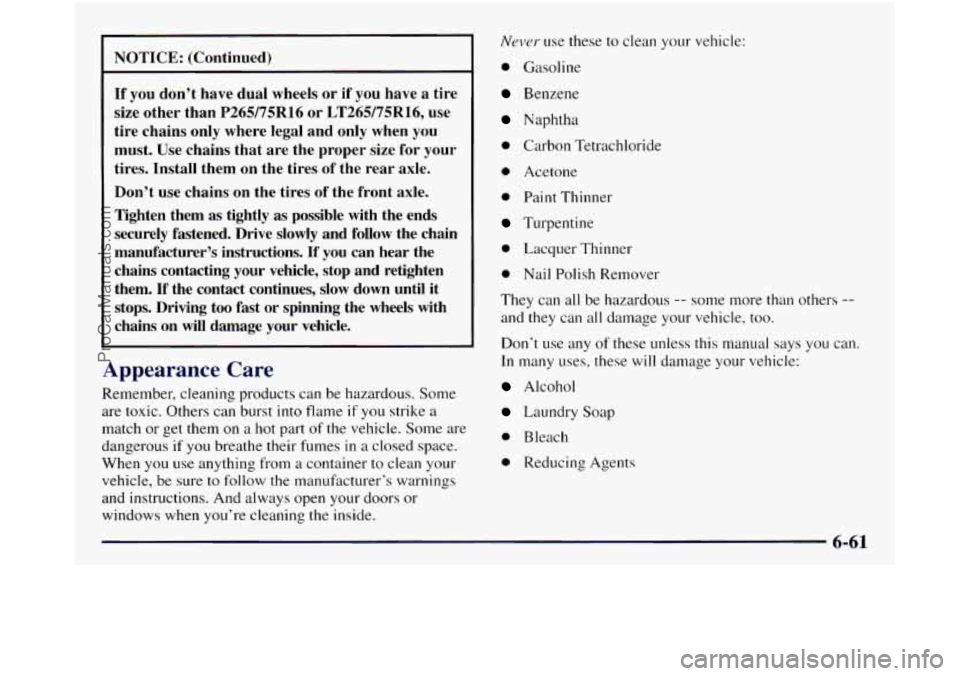
NOTICE: (Continued) -
If you don’t have dual wheels or if you have a tire
size other than
P265/75R16 or LT265/75R16, use
tire chains only where legal and only when you
must. Use chains that are the proper size for your
tires. Install them on the tires of the rear axle.
Don’t use chains on the tires of the front axle.
Tighten them
as tightly as possible with the ends
securely fastened. Drive slowly and follow the chain
manufacturer’s instructions. If you can hear the
chains contacting your vehicle, stop and retighten
them.
If the contact continues, slow down until it
stops. Driving too fast or spinning the wheels with
chains on will damage your vehicle.
Appearance Care
Remember, cleaning products can be hazardous. Some
are toxic. Others can burst into flame
if you strike a
match or get them on
a hot part of the vehicle. Some are
dangerous if
you breathe their fumes in a closed space.
When you use anything from
a container to clean your
vehicle, be sure
to follow the manufacturer’s warnings
and instructions. And always open your doors or
windows when you’re cleaning the inside.
NevcJr use these to clean your vehicle:
0 Gasoline
Benzene
Naphtha
0 Carbon Tetrachloride
0 Acetone
0 Paint Thinner
Turpentine
0 Lacquer Thinner
0 Nail Polish Remover
They can
all be hazardous -- some more th .an others --
and they can all damage your vehicle, too.
Don’t use any
of these unless this manual says you can.
In many uses, these will damage your vehicle:
Alcohol
Laundry Soap
0 Bleach
0 Reducing Agents
6-61
ProCarManuals.com
Page 355 of 452
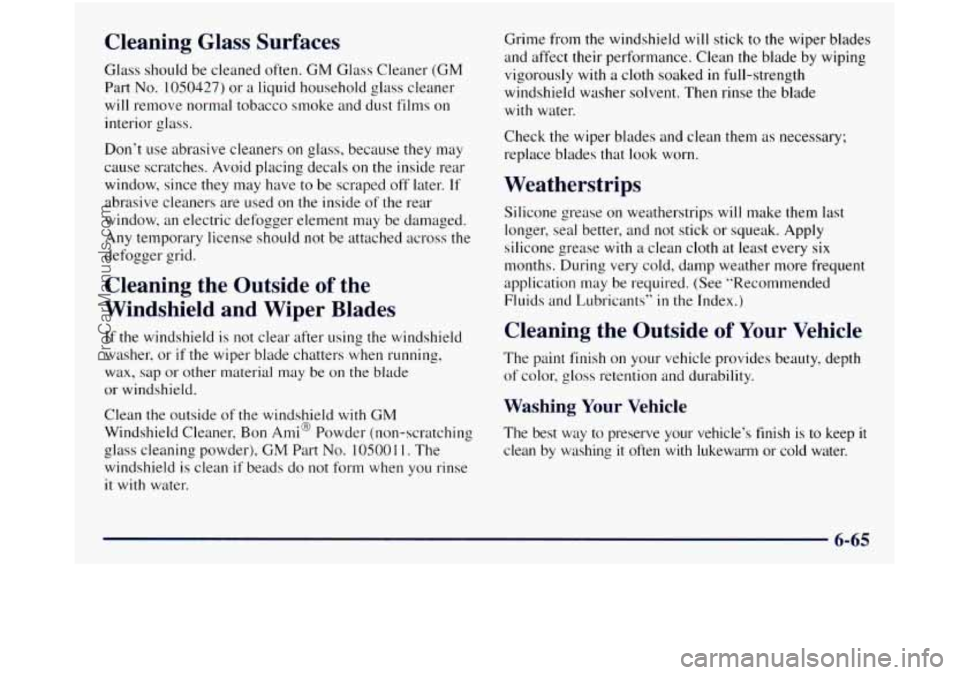
Cleaning Glass Surfaces
Glass should be cleaned often. GM Glass Cleaner (GM
Part
No. 1050427) or a liquid household glass cleaner
will remove normal tobacco smoke and dust films on
interior glass.
Don’t use abrasive cleaners
on glass, because they may
cause scratches. Avoid placing decals
on the inside rear
window, since they may have to be scraped off 1ate.r.
If
abrasive cleaners are used on the inside of the rear
window, an electric defogger element may be damaged.
Any temporary license should
not be attached across the
defogger grid.
Cleaning the Outside of the
Windshield and Wiper Blades
If the windshield is not clear after using the windshield
washer. or
if the wiper blade chatters when running,
wax, sap
or other material may be on the blade
or windshield.
Clean the outside of the windshield with GM
Windshield Cleaner, Bon Ami@ Powder (non-scratching
windshield is clean
if beads do not form when you rinse
it with water.
= olass cleaning powder), GM Part No. 10500 I 1. The Grime from
the windshield will stick to the wiper blades
and affect their performance. Clean the blade by wiping
vigorously with
a cloth soaked in full-strength
windshield washer solvent. Then rinse the blade
with water.
Check the wiper blades
and clean them as necessary;
replace blades that
look worn.
Weatherstrips
Silicone grease on weatherstrips will make them last
longer, seal better, and not stick or squeak. Apply
silicone grease with a clean cloth at least every six
months. During very cold, damp weather more frequent
application may be required. (See “Recommended
Fluids and Lubricants”
in the Index.)
Cleaning the Outside of Your Vehicle
The paint finish on your vehicle provides beauty, depth
of color, gloss retention and durability.
Washing Your Vehicle
The best way to preserve your vehicle’s finish is to keep it
clean by washing it often with lukewarm or cold water.
6-65
ProCarManuals.com
Page 361 of 452
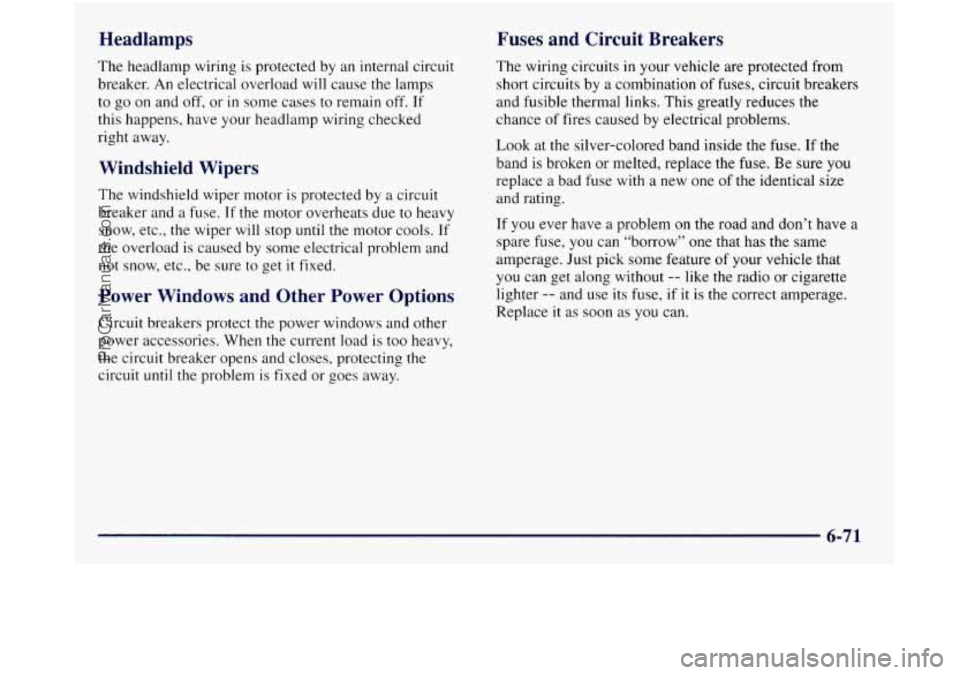
Headlamps Fuses and Circuit Breakers
The headlamp wiring is protected by an internal circuit
breaker. An electrical overload will cause
the lamps
to go on and off, or
in some cases to remain off. If
this happens, have your headlamp wiring checked
right away.
Windshield Wipers
The windshield wiper motor is protected by a circuit
breaker and
a fuse. If the motor overheats due to heavy
snow, etc., the wiper will stop
until the motor cools. If
the overload is caused by some electrical problem and
not snow, etc., be sure to get it fixed.
Power Windows and Other Power Options
Circuit breakers protect the power windows and other
power accessories. When the current load is too heavy,
the circuit breaker opens and closes, protecting the
circuit
until the problem is fixed or goes away. The wiring circuits
in your vehicle are protected from
short circuits by
a combination of fuses, circuit breakers
and fusible thermal links.
This greatly reduces the
chance
of fires caused by electrical problems.
Look at the silver-colored band inside the fuse. If the
band is broken or melted, replace the fuse. Be sure you
replace
a bad fuse with a new one of the identical size
and rating.
If you ever have
a problem on the road and don’t have a
spare fuse, you can “borrow” one that has the same
amperage. Just pick some feature
of your vehicle that
you can get along without
-- like the radio or cigarette
lighter
-- and use its fuse, if it is the correct amperage.
Replace
it as soon as you can.
6-7 1
ProCarManuals.com
Page 364 of 452

Fuse/Circuit Breaker Usage
20
21
22
23
24
A
B
PRNDL, Automatic Transmission,
Speedometer, Check Gages
Warning Light
Security/Steering
Not Used
Not Used
Front Axle,
4WD Indicator Lamp,
TP2 Relay (Gasoline Engine)
Power Door Lock, Six-Way Power Seat, Keyless Entry Module
Power Windows
Underhood Fuse/Relay Center
The underhood fusehelay center is located in the rear of
the engine compartment near the brake fluid reservoir.
Move the retainer clips
for the cover to access the
fuse block.
You can remove fuses with a fuse extractor. The fuse
extractor
is mounted to the interior fuse block. TO
remove fuses
if you don’t have a fuse extractor, hold the
end of the fuse between your thumb and index finger
and pull straight out.
6-74
ProCarManuals.com
Page 365 of 452

STARTER RELAY
[-I
[-I
[T)
I BLOWER
n STOPiHAZ
Name
ECM-B RR DEFOG
IGN-E
FUEL
SOL
GLOW PLUG
Usage
Horn, Underhood Lamps
Auxiliary Fan
Injectors, PCM/VCM
Not Used
Air Conditioning
Not Used
Ignition Switch, EGR, Canister
Purge, EVRV Idle Coast Solenoid,
Heated
02, Fuel Heater
(Diesel Engine), Water Sensor
(Diesel Engine)
HTD ST-RR Not Used
LIGHTING Headlamp and Panel Dimmer
BATT Battery, Fuse Block Busbar
IGN-A Ignition Switch
IGN-B Ignition Switch Switch,
Fog and Courtesy Fuses
ABS Anti-Lock Brake Module
BLOWER High Blower Relay
STOP/HAZ Stoplamps
HEATED SEATS Not Used
6-75
Usage
Fuel Pump, PCM/VCM
Rear Window Defogger
Auxiliary Fan Relay Coi
il, AIC
Compressor Relay, Hot Fuel
Module, Dual Tanks
Fuel Solenoid (Diesel Engine)
Glow Plugs (Diesel Engine)
Name
HORN
AUX FAN
ECM- 1
HTD ST-FR
AIC HTD MIR
ENG-
1
ProCarManuals.com
Page 437 of 452
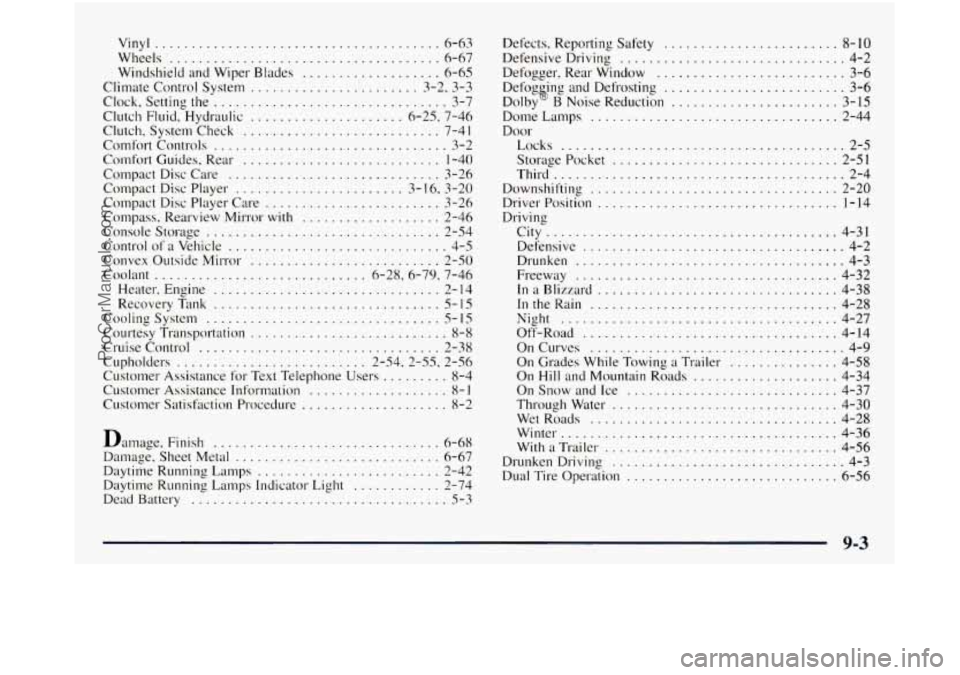
Vinyl ....................................... 6-63
Wheels
..................................... 6-67
Windshield and Wiper Blades
................... 6-65
Clock. Setting the ................................ 3-7
Clutch Fluid. Hydraulic
..................... 6-25. 7-46
Clutch. System Check
........................... 7-41
Comfort Controls
................................ 3-2
Comfort Guides. Rear
........................... 1-40
Compact Disc Care
............................. 3-26
Compact Disc Player
.......................
3-16 . 3-20
Compact Disc Player Care
........................ 3-26
Compass. Rearview Mirror
with ................... 2-46
Console Storage
................................ 2-54
Control
of a Vehicle .............................. 4-5
Convex Outside Mirror .......................... 2-SO
Coolant ............................. 6-28.6-79.7-46
Heater
. Engine ............................... 2- 14
Recovery Tank ............................... 5- I5
Cooling System ................................ 5- IS
Courtesy Transportation ........................... 8-8
Cruise Control
................................. 2-38
Cupholders
.......................... 2.54.2.55. 2-56
Customer Assistance Information ................... 8- I
Customer Satisfaction Procedure .................... 8-2
Climate Control System ....................... 3.2 . 3-3
Customer Assistance for Text Telephone Users
......... 8-4
Damage. Finish
............................... 6-68
Darnage. Sheet Metal
............................ 6-67
Daytime Running Lamps
......................... 2-42
Daytime Running Lamps Indicator Lighl
............ 2-74
Dead Battery
................................... 5-3
Defects. Reporting Safety ........................ 8- 10
Defensive Driving ............................... 4-2
Defogger. Rear Window .......................... 3-6
Defoggng
and Defrosting ......................... 3-6
Dolby B Noise Reduction
....................... 3-15
Dome Lamps
.................................. 2-44
DO0
I.
Locks ....................................... 2-5
Storage Pocket ............................... 2-51
Third
........................................ 2-4
Downshifting
.................................. 2-20
Driver Position ................................. 1-14
Driving City
........................................ 4-31
Defensive
.................................... 4-2
Drunken
..................................... 4-3
Freeway
.................................... 4-32
In a Blizzard ................................. 4-38
In the Rain .................................. 4-28
Night
...................................... 4-27
Off-Road
................................... 4-14
On Curves
................................... 4-9
On Grades While Towing a Trailer ............... 4-58
On Hill and Mountain Roads .................... 4-34
On Snow and Ice
............................. 4-37
Through Water
............................... 4-30
Wet Roads
.................................. 4-28
Winte
l- ...................................... 4-36
With
a Trailer ................................ 4-56
Drunken Driving
................................ 4-3
Dual Tire Operation
............................. 6-56
9-3
ProCarManuals.com